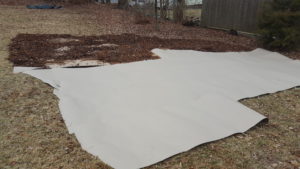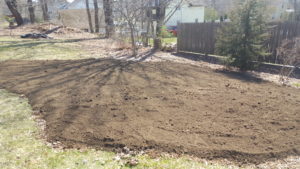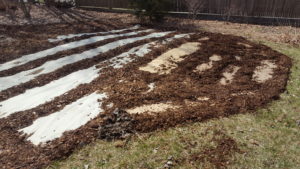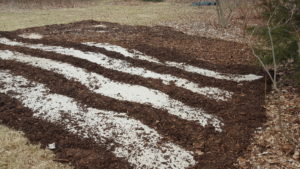by Leslie Duthie
The lawn takes on many connotations for all of us. It is a place to meet, a place for  kids to play, to relax, the ultimate suburban habitat. Lawns can also be hard work – our lawns need water and require fertilizer to keep that deep green lushness yet provide little in the way of habitat or ecological value for anything other than humans. From an ecological standpoint, I started to rethink the importance of the “lawn” and to consider a smaller lawn or lawn alternatives that do not require fertilizer, water, or much mowing. Ultimately, I decided the best solution would be to replace the lawn with new gardens.
kids to play, to relax, the ultimate suburban habitat. Lawns can also be hard work – our lawns need water and require fertilizer to keep that deep green lushness yet provide little in the way of habitat or ecological value for anything other than humans. From an ecological standpoint, I started to rethink the importance of the “lawn” and to consider a smaller lawn or lawn alternatives that do not require fertilizer, water, or much mowing. Ultimately, I decided the best solution would be to replace the lawn with new gardens.
I have never used much fertilizer or water on the lawn, so it is a mix of weeds, dandelions, violets, pussytoes, clover, and some turf. As a result, I can forgo mowing for more extended periods, forget watering, and do without the fertilizer entirely. It may not look great all year, but it was useful when my children were young and needed places to play and gather with friends. Now that the children are grown and my husband and I built a patio for gathering, it was time to reduce the lawn.
Bring on the Cardboard
In the past, I would have undertaken the long and arduous task of removing whatever sod or plants that were impeding the creation of new garden spaces. That digging also meant losing whatever topsoil and organic matter accumulated in the soil and creating a large pile of sod to compost. I could use herbicides or solarize the lawn by covering it with clear plastic, but what else was being killed in the process?
None of those options seemed appropriate, so in the early spring of 2020, stuck at home, I undertook lawn murder using a different method. A method I found to be easy and manageable no matter your space’s size. The pandemic required each of us to purchase items online that were delivered to our houses. Groceries, pet supplies, furniture, home improvement, and organizational items all came in a box. I began collecting cardboard boxes (preferably plain brown ones with little printing) and realized that I could also scavenge my neighbor’s cardboard boxes on recycling day.

Rather than digging or using herbicides to kill the lawn, I could lay pieces of cardboard over the surface of the grass to smother it. Cardboard degrades quickly while also smothering whatever plants are beneath it. I was fortunate to have access to a large amount of decomposing wood chips to hold the cardboard in place. Other than decomposed wood chips, you can consider using small logs, branches, manure, compost, or just soil to keep the cardboard in place.
Once I had used up all my collected cardboard, I realized I wanted more. I purchased Ram Board at my local hardware store. Ram Board is cardboard material used by renovators to protect your floors during remodeling. It comes in large rolls and can be cut to any length. You can see in the picture below that I used a lot of woodchips to hold down boxes of various sizes. On the Ram Board, I only had to put chips along the seams of the cardboard. Finally, after covering a large rectangular area, I wanted to shape my new garden area, so I retrieved additional boxes and used them to make a more rounded area rather than another big square. In all, I have killed almost 1000 square feet of former lawn.
- I extended the garden edges to prevent having a ‘square’ garden.
- Wood chips hold down the cardboard.
Planting Time for the Annual Seeds
At this point, several options are available: The cardboard needs some kind of cover to help it stay moist and degrade while opening up a planting area. A light coating of compost or soil would be sufficient to break down the cardboard, and I could begin planting in late summer or early fall. I could have applied the decomposed wood chips across the entire surface and allowed them to decompose with the cardboard, in which case I could plant the following year. I was ready to plant the first spring, so instead, I ordered a mix of topsoil and compost and covered all of the cardboard and wood chips with a 2” to 4” layer of soil.
I have expanded my narrow strip garden along a fence line into a larger garden bed. There is a saucer magnolia at the back corner of the new garden, and I left a red cedar and blueberries along the fence. That existing strip of the garden already has many sun-loving perennials, species you would find in a meadow. My goal was to use the expanded garden area to create a more meadow-like setting in this section of the yard and to attract more wildlife to my corner of suburbia.

A mix of soil and compost covers the cardboard and woodchips.
This article is reprinted with permission of the Ecological Landscape Alliance. Please continue reading the article here.


